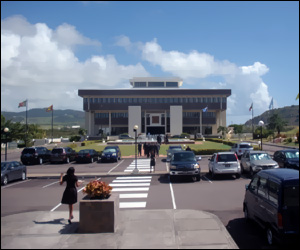
ECCB Headquarters
Basseterre, St. Kitts – Nevis
December 05, 2013 (CUOPM)
The Eastern Caribbean Central Bank (ECCB) is reporting that preliminary data suggest that economic activity in St. Kitts and Nevis rose in the first half of 2013.
This increase resulted from a rebound of the construction sector and estimates of increased economic activity in the hotels and restaurants and wholesale and retail trade sectors.
The June 2013 Economic and Financial Review released by the Eastern Caribbean Central Bank on October 29 , states that cconsumer prices fell by 0.4 per cent, on an end of period basis.
The fiscal operations of the Federal Government resulted in an improvement of the overall surplus over the comparable period of 2012.
The total outstanding public sector debt of the Federal Government fell during the period under review. In the banking system, monetary liabilities and net foreign assets increased while domestic credit fell. Commercial bank liquidity rose and the weighted average interest rate spread between loans and deposits narrowed.
The ECCB Report which comes just ahead of the presentation of the 2014 Budget Address stated that economic activity in St. Kitts and Nevis is expected to improve in 2013 relative to 2012 premised on expectations of a continued rebound of the construction sector and positive growth in the tourism industry.
Growth in these two sectors is expected to lead to direct and indirect positive spill over impacts on related sectors such as; wholesale and retail trade, and real estate, renting and business activity.
Public sector construction activity is anticipated to be driven mainly by the rehabilitation of the Dr. Kennedy Simmonds Highway in St. Kitts and continued efforts on a water enhancement project in Nevis.
It stated that in the private sector, work on major developments including the commercial park at Golden Rock, the completion of Phase One of Kittitian Hill, the start of works on Imperial Bay Beach and Golf Residences and the expansion of the Four Seasons Resort in Nevis bode well for the sector.
Expectations of positive value added in the tourism industry, are contingent on the successful introduction of additional airlift to the Federation in the fourth quarter of 2013 by a major United States of America air carrier.
These projections however are tempered by expectations of a tapering off in the value added contribution of the manufacturing sector following previous positive growth.
The fiscal operations of the Federal Government are projected to benefit from both high levels of revenues associated with the Citizenship by Investment Program and the containment of expenditure outlays, as espoused by the standby arrangement with the IMF.
Risks to this outlook stem from a failure of work on tourism related projects to materialize as envisaged and the impact of the additional airlift being muted on account of weak stay over arrivals.